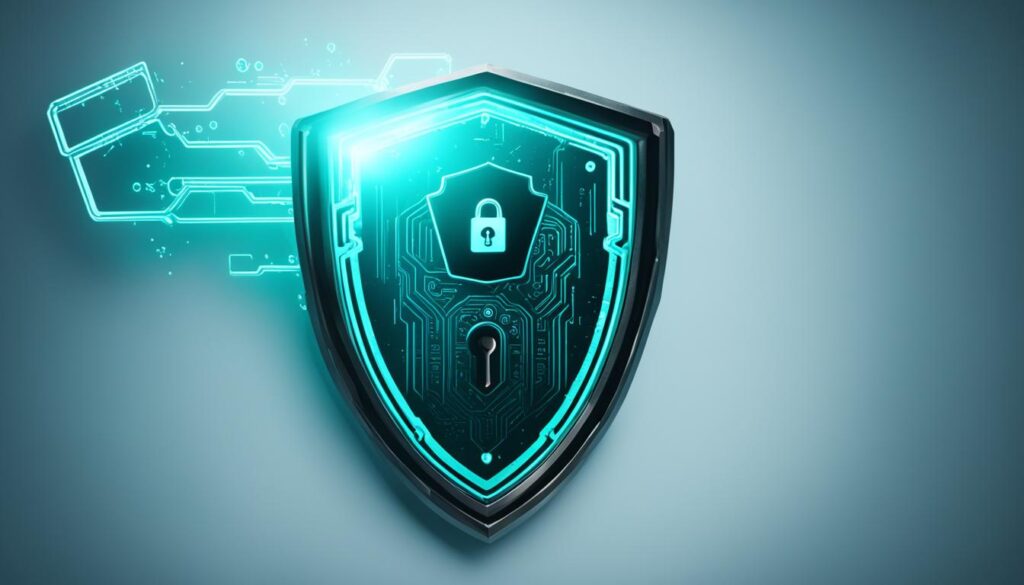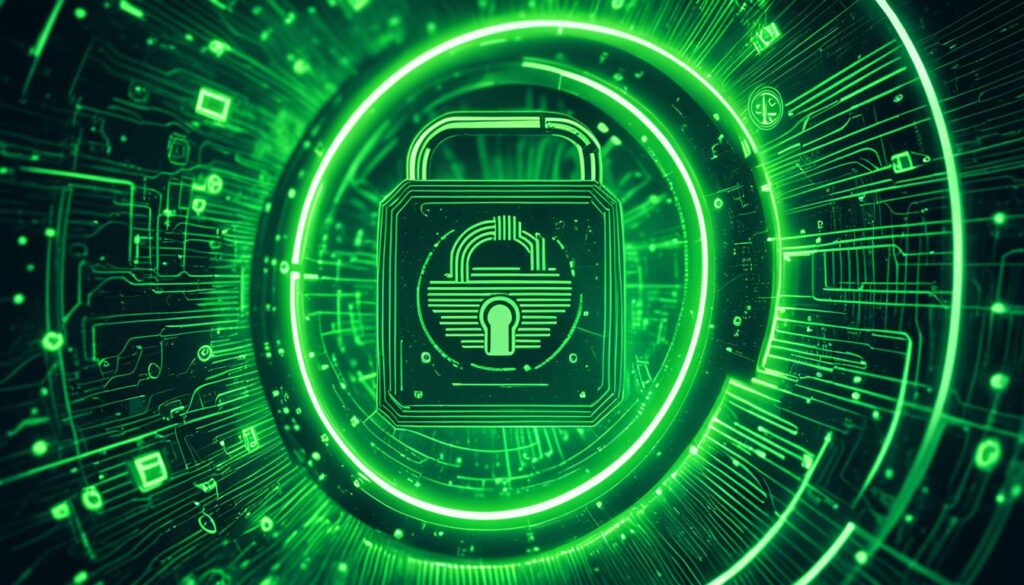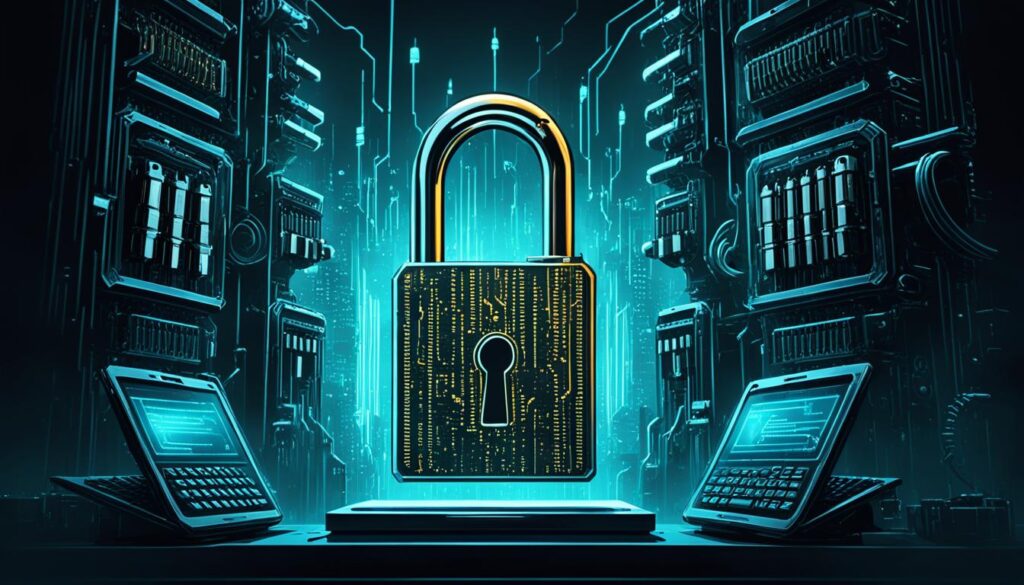It’s a jarring number that gives pause to even the most seasoned software developers: over 70% of organizations reported being victims of a successful cyber attack in the past year alone. This staggering figure underscores the vital importance of a robust digital security strategy to protect software integrity from the incessant threats of cybercrime. One often overlooked champion in this arena is the use of code signing certificates—a powerful tool in a developer’s arsenal to safeguard their creations from unauthorized tampering and imposter software. Not all code signing methods are created equal; the choice between hardware and software code signing involves a careful balancing act between security and convenience. Recognizing the role of a trusted certificate authority in this process is just the beginning.
Key Takeaways
- Understanding the importance of code signing certificates is crucial for a digital security strategy.
- Choosing the right code signing method can protect the software integrity against unauthorized alterations.
- Recognize that a trusted certificate authority plays a pivotal role in ensuring the validity and trustworthiness of code signing certificates.
- Hardware and software code signing offer varying levels of security, each with its own set of benefits and constraints.
- The management of the private key is a defining difference between hardware and software code signing approaches.
Understanding Code Signing Certificates
As threats to digital security evolve, the importance of secure digital signatures cannot be overstated. Code signing certificates are vital for maintaining the trustworthiness of software in an ever-connected world. Not only do they assert the source of the software, but they also act as a stamp of approval confirming that the software is unaltered post-signature, thus playing a crucial role in digital security solutions.
The Role of Code Signing in Digital Security
 In the digital sphere, the outcry for comprehensive security measures is paramount. With code signing certificate benefits at the forefront, developers and consumers alike can be assured of the software’s authenticity and safety. These certificates provide a buffer against the unauthorized distribution of modified or counterfeit software, thereby protecting against the severe implications of a compromised digital ecosystem.
In the digital sphere, the outcry for comprehensive security measures is paramount. With code signing certificate benefits at the forefront, developers and consumers alike can be assured of the software’s authenticity and safety. These certificates provide a buffer against the unauthorized distribution of modified or counterfeit software, thereby protecting against the severe implications of a compromised digital ecosystem.
How Code Signing Protects Software Integrity
Integrity is the heartbeat of software security. Code signing certificates ensure this by offering a line of defense against tampering and unauthorized modifications. They serve as the invisible force field, keeping malign intent at bay and securing the trust between software producers and end-users. Let’s delve into the two predominant types of Code Signing Certificates: Organization Validated (OV) and Extended Validation (EV) Certificates.
| Features | Organization Validated (OV) Certificates | Extended Validation (EV) Certificates |
|---|---|---|
| Vetting Process | Traditional vetting | Stringent verification measures |
| Security Measures | Key stored digitally | Key stored on physical hardware token |
| Level of Assurance | Standard level of identity confirmation | High assurance of developer’s identity |
| Beneficial For | Software requiring regular, timely updates | Software demanding the highest level of trust |
| User Trust | Establishes basic trust in software source | Cements user trust with rigorous validation |
Both OV and EV offer their unique take on digital security solutions, with EV leading the charge in providing the highest level of assurance with its strict vetting process and secure hardware storage of digital keys. The choice between OV and EV certificates largely depends on the level of security and trust a developer wants to instill in their software and its end-users.
Exploring Hardware-Based Code Signing
The realm of digital security is increasingly recognizing the importance of hardware code signing as a robust solution for protecting software authenticity and preventing cyber threats. When it comes to maintaining the integrity of digital signatures, hardware tokens wielded by authorized individuals stand as the bastion against security breaches.
The Use of Hardware Tokens for Secure Digital Signatures
Hardware tokens, often perceived as the guardians of private keys, play a pivotal role in the infrastructure of hardware code signing. These pocket-sized devices serve as the exclusive medium to access and deploy secure digital signatures, ensuring that only the rightful owner can sign and distribute software. This level of controlled access is paramount, especially when dealing with sensitive applications that underpin the security of countless users.

Trusted Certificate Authority and Hardware Solutions
The integrity of a hardware-based signing process is also contingent upon the involvement of a trusted certificate authority. These entities are not only responsible for verifying the identity of the certificate seeker but also for producing and distributing the hardware tokens that encapsulate the private keys. It is this synergy between hardware solutions and reputable authorities that fortifies the chain of trust and renders software less susceptible to tampering and piracy.
Whether it’s for applications that require stringent compliance with industry standards or driver software seeking to establish uncompromised credibility, hardware code signing stands out for its ability to secure digital signatures with an ironclad approach. By choosing this route, software publishers can ensure that their digital offerings maintain an unbroken seal of authenticity and integrity from development to end-user deployment.
Diving into Software Code Signing
Exploring the realm of software code signing certificates unveils a flexible and accessible solution designed to protect software integrity. These certificates provide crucial code signing benefits by allowing developers to store the private key within their own secure environment, streamlining the process of maintaining and updating software.

Software code signing enhances security while offering the convenience necessary for teams operating across various locations. This adaptability is particularly beneficial for organizations that need to ensure the authenticity of their software while managing frequent updates or patches.
| Feature | Benefit |
|---|---|
| Private Key Storage | Stored within developer’s secure environment |
| Geographical Flexibility | Accessible for teams around the world |
| Type of Certificate | Mostly Organization Validated (OV) certificates |
| Vetting Process | Less rigorous, faster issuance |
| Software Launch Stage | Suitable for software post-launch |
| User Trust | Digital signature upholds software integrity |
The procurement of a software code signing certificate is inherently designed to meet the dynamic needs of software developers. It underscores the synergy between accessibility and security, without compromising the trust placed by end-users in a digital ecosystem increasingly conscious of cybersecurity.
Comparing Hardware vs Software Code Signing Certificates
In today’s technology-driven landscape, digital security solutions are of paramount importance. When it comes to safeguarding software, choosing the right type of code signing certificate is a critical decision for developers. Here, we focus on the stark contrasts between hardware and software certificates, which serve as the foundation for establishing trust and authenticity in the virtual realm.
Key Differences in Security Practices
Hardware and software code signing certificates stand apart in their approach to managing and storing private keys. Hardware solutions, often used in conjunction with EV Code Signing Certificates, offer robust security by physically securing the private key within an external token. This method largely eliminates the risk of private key theft or misuse since the token must be present to sign the code. Software code signing certificates, common for OV Certificates, keep the private key on the developer’s system. While this presents a larger surface for potential security breaches, it also allows for quicker and more flexible code signing processes.

Pros and Cons of Each Method
-
Hardware Code Signing Certificates:
- Pros: High-level security, reduced risk of key compromise, a physical token that can safely store keys.
- Cons: May be less convenient for teams needing quick access to signing capabilities; typically has higher upfront costs.
-
Software Code Signing Certificates:
- Pros: More accessible for developers, easier to manage and distribute across teams, and generally quicker to implement.
- Cons: Higher risk of key exposure and potential security vulnerabilities; relies on the developer’s security measures.
In comparing hardware vs software code signing certificates, it’s essential to weigh these considerations alongside the specific needs of your software development lifecycle and digital security solutions strategy. The choice between a hardware or software certificate can ultimately impact not only the security of your code but also the trust it instills in your end-users.
Extended Validation (EV) Code Signing Certificates
When developers and organizations aim to establish unshakable trust in their software, EV code signing certificates stand out as the premier choice. By offering far more stringent validation procedures than conventional certificates, EV code signing certificates require that every applicant is thoroughly vetted to confirm their legal and operational status. These certificates, serving as a hallmark of security and integrity, carry the weight of secure digital signatures trusted by both industry professionals and end-users.
Unlike other certificates, EV code signing involves a unique distribution of the private key—it’s securely embedded in a physical hardware token. This token, shipped to the certificate’s proprietor, is the only means of signing code, making it virtually impregnable to external threats. Moreover, this sophisticated level of code protection comes without a hefty price tag. EV certificates are an affordable investment in digital security, with options for multi-year packages offering long-term reassurance for software publishers and recipients alike.
With Microsoft SmartScreen recognition, software signed with an EV code signing certificate benefits from an immediate trust boost in users’ eyes. SmartScreen, a potent security feature from Microsoft, employs reputation-based screening to caution users against untrusted software. EV code signing certificates streamline this reputation-building process, ensuring that even new applications can bypass SmartScreen warnings from day one, thus greatly enhancing user confidence and software adoptability.
| Feature | Benefit |
|---|---|
| Extensive Verification | Confirms legal and operational status of the entity, building strong trust. |
| Hardware Token | Secures the private key and creates a robust barrier against unauthorized access. |
| Microsoft Authenticode & Kernel Mode Integration | Ensures uninterrupted software functionality with secure updates. |
| Microsoft SmartScreen Recognition | Accelerates user trust, offering protection from untrusted software sources. |
| Cost-Effective Multi-Year Packages | Provides a long-term, budget-friendly security solution for software publishers. |
To summarize, the pinnacle of secure software distribution is embodied by EV code signing certificates. Not only do they signify a rigorous validation process and incorporate physical hardware for key security but also they gel seamlessly with Microsoft SmartScreen to offer end-users peace of mind when downloading and using software. For developers, the clear message is that the upfront investment in EV code signing certificates yields invaluable dividends in the currency of user trust and software integrity.
Benefits of EV Code Signing Over Regular Code Signing
Extended Validation (EV) Code Signing represents a significant advancement in the realm of software security and digital trust. Opting for an EV Code Signing certificate means choosing a comprehensive security measure that not only enhances the credibility of your software but also reinforces the trust users place in digital signatures.
Enhancing Trust with EV Code Signing Certificates
The role of a trusted certificate authority is paramount when it comes to EV Code Signing. They ensure that the private keys are securely mailed and stored on a hardware token, which significantly limits the possibility of unauthorized access. When software developers or distributors choose EV Code Signing, they are not merely investing in a digital certificate but are also building a foundation of trust with their user base. Acknowledged by major operating systems and software platforms, these certificates establish a stronger level of validation and security.
Microsoft SmartScreen Recognition and User Safety
One of the standout benefits of EV code signing is the immediate recognition by the Microsoft SmartScreen filter. This feature works tirelessly to safeguard users from malicious content, and it affords a higher level of trust to software passed through its filter. EV Code Signing certificates come with the added value of being pre-trusted by Microsoft SmartScreen, which means reduced warning messages for users and smoother installation processes.
The following table highlights the direct comparison between the EV and regular OV Code Signing certificates, emphasizing their unique benefits and the assured security that comes with EV:
| Feature | EV Code Signing Certificate | Regular OV Code Signing Certificate |
|---|---|---|
| Private Key Storage | Hardware Token | Developer’s Infrastructure |
| Microsoft SmartScreen Recognition | Immediate Trust | Delayed Trust Development |
| User Trust & Safety | Enhanced via Hardware Token and SmartScreen Compatibility | Based on Code Reputation Over Time |
| Platform Compatibility | Robust Across Multiple Platforms | Limited to Specific Platforms |
| Cost Effectiveness | Higher Initial Cost with Long-Term Benefits | Lower Initial Cost with Potential Ongoing Security Costs |

The clear advantages of the EV Code Signing certificates over their OV counterparts place them at the forefront for developers and organizations who prioritize security and trust in their software distribution. By opting for the EV route, you ensure that your users receive the most secure and reliable software experience possible.
Regular Code Signing: The Organization Validated (OV) Approach
In the realm of digital security, OV code signing certificates stand as a robust means to protect software integrity. These certificates follow a standardized vetting process, which is designed to build trust between software providers and users without requiring the stringent measures associated with Extended Validation (EV) code signing methods.
One key advantage of OV code signing is the flexibility it provides developers when it comes to software updates and maintenance. Since the private key is stored within the developers’ system, authorized personnel can easily access and sign code, serving as an efficient solution especially critical for software requiring frequent iterations or urgent patches.
- Swift access for authorized team members to sign software
- Ideal for multi-platform software distribution
- Standard vetting process ensures a foundation of trust
Moreover, digital security solutions need to be accessible, ensuring that all levels of developers can implement them to protect their software. OV certificates contribute to this by offering a balance between security and practicality. Transitioning to OV code signing can be an intelligent move for developers whose software is already in the public domain and may not necessitate the heightened security that comes with a hardware-based approach.
Although Organization Validated certificates do not embody the same level of security as EV certificates, they are not lacking in efficacy. The authenticity these certificates provide helps maintain the reputation of the software, reassuring end-users of the software’s credibility. All said and done, OV certificates serve as a fundamental component of digital security solutions, designed to protect software integrity and maintain user trust.
How Code Signing Certificates Prevent Malware Attacks
In the relentlessly evolving cyber security landscape, code signing certificates stand as a bastion of digital safety, effectively mitigating the susceptibility to malware attacks. These certificates are not merely a buffer but an active fortification of the trust bridge between developers and users. Through the diligent application of code signing certifications, software authenticity is assured, securing digital exchanges that could otherwise be vulnerable to exploitation.
Securing Digital Exchanges Through Code Signing
It’s imperative to recognize the pivotal role that code signing certificates play in securing digital exchanges against deceptive malware infiltration. By embedding secure digital signatures within the software, any alteration to the code is detectable, preventing the spread of unauthorized or compromised applications. Therefore, the promise of code signing certificates to prevent malware is not just a claim but a proven defense mechanism that maintains the sanctity of digital interaction and commerce.
Code Signing as a Shield Against Software Tampering
The hash functions and key pairs intrinsic to code signing practice serve as a robust shield for software tampering protection, encompassing the software’s journey from developer to end-user. This function ensures the integrity of the code—it has not been meddled with post-signature. Indeed, the importance of these certificates transcends mere compliance; they embody a commitment to digital security, reassuring both providers and consumers that they are participating in a safe and reliable software distribution network.
FAQ
What is a code signing certificate?
A code signing certificate is a digital certificate used by software developers to sign their programs and applications. It serves as a virtual ‘shrinkwrap’ that ensures the software’s source is authentic and hasn’t been altered or corrupted after the certificate was applied. It’s a critical component of a digital security strategy to protect software integrity.
How does code signing add to digital security?
Code signing enhances digital security by offering secure digital signatures that verify the legitimacy of software publishers and the integrity of the software. When users download signed software, they can be confident that the code is genuine and hasn’t been tampered with since signing. This trust is key to protecting against malware and unauthorized software modifications.
What are the differences between hardware and software code signing certificates?
The main difference lies in how the code signing certificates handle the private key. Hardware code signing certificates involve storing the private key on a physical hardware token, providing an added layer of security. This method is typically associated with Extended Validation (EV) Code Signing Certificates. Software code signing certificates store the private key within the developer’s environment, which can be more convenient but presents a higher risk if not adequately protected.
What are the advantages of using a hardware token for code signing?
Hardware tokens used in code signing offer an increased level of security. Since the private key is stored offline and cannot be easily accessed, copied, or stolen, it is significantly less vulnerable to hacking attempts. With hardware tokens, developers and organizations can ensure their software’s integrity and uphold a robust digital security strategy.
Why is a trusted certificate authority important?
A trusted certificate authority (CA) plays a crucial role by issuing code signing certificates and ensuring that the issuer is a legitimate and secure entity. CAs perform stringent verification processes to make sure that the entity requesting the certificate is trustworthy. This validation is essential for maintaining user confidence and ensuring safe digital exchanges between the software provider and consumers.
When should a developer choose an EV code signing certificate over an OV certificate?
Developers should opt for an EV code signing certificate if they require the highest level of security and trust from their end-users, especially for high-risk software such as device drivers or system software. EV certificates undergo a more extensive verification process and come with hardware security measures to store the private key, providing stronger assurance of the software’s authenticity and integrity.
What benefits does the Microsoft SmartScreen recognition offer for EV code signing certificates?
Microsoft SmartScreen recognition offers a significant benefit for EV code signing certificates by building an immediate trust reputation. This means that software signed with EV certificates is less likely to trigger warnings or be blocked by Microsoft SmartScreen filters, providing an efficient user experience and further protecting against malware and other security threats.
How can OV code signing certificates help protect software integrity?
OV code signing certificates are designed for developers who need to maintain and update their software securely. These certificates provide a standard level of validation that attests to the legitimacy of the software publisher and ensures the integrity of the code. They allow for easier software updates and modifications since the key is stored in the software environment and is more accessible for authorized changes.
How do code signing certificates prevent malware attacks?
Code signing certificates mitigate malware attacks by assuring users about the authenticity and integrity of downloaded software. They use hashing to secure the software’s code and a public-private key to verify its source, creating a digital fingerprint. This process deters hackers from distributing malware through fake or altered versions of legitimate software, ensuring a safer digital environment for users.





